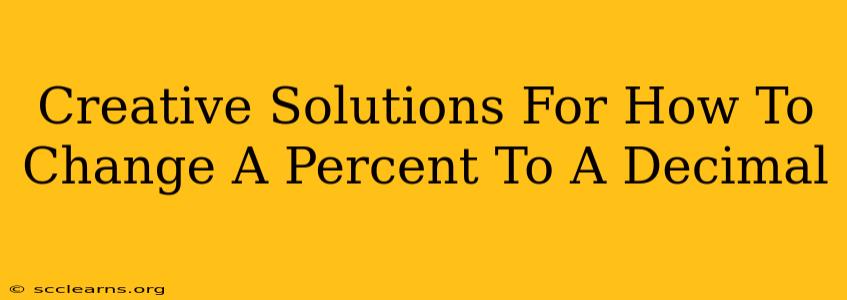Converting a percentage to a decimal might seem like a simple math problem, but understanding the why behind the method is key to truly mastering it and applying it creatively in various contexts. This isn't just about rote memorization; it's about unlocking a fundamental concept in numerical representation. Let's explore some creative ways to approach this conversion, moving beyond the typical textbook method.
Understanding the Core Concept: Percentages and Decimals
Before diving into creative solutions, let's solidify the foundational understanding. A percentage represents a fraction out of 100. The word "percent" literally means "out of one hundred" ( per cent). Therefore, 25% means 25 out of 100, which can be written as the fraction 25/100. Decimals, on the other hand, represent parts of a whole using powers of ten. The key is seeing the connection: both percentages and decimals represent parts of a whole.
Creative Solution #1: The Visual Approach - Pie Charts and Bar Graphs
Imagine a perfectly round pie. The whole pie represents 100%. If you want to represent 25%, you'd visually divide the pie into four equal slices, each representing 25%. Each slice's area visually corresponds to 0.25 (the decimal equivalent of 25%). This visual method is great for beginners, especially those who learn best through visual aids. You can extend this to bar graphs, where the whole bar is 100%, and the length of a segment represents a specific percentage and its decimal equivalent.
Creative Solution #2: The Fraction Bridge
This method uses fractions as a bridge between percentages and decimals. Let's take 75% as an example:
- Convert to a fraction: 75% means 75/100.
- Simplify the fraction: 75/100 simplifies to 3/4.
- Convert to a decimal: Divide the numerator (3) by the denominator (4). 3 ÷ 4 = 0.75
This method reinforces fraction skills while demonstrating the inherent relationship between fractions, percentages, and decimals.
Creative Solution #3: The "Move the Decimal" Shortcut
This is a common shortcut, but let's understand why it works:
- The Percentage Point: The percentage symbol (%) implicitly means "divided by 100".
- Dividing by 100: Dividing a number by 100 moves the decimal point two places to the left.
Example: To convert 35% to a decimal, simply remove the percentage sign and move the decimal point two places to the left: 35% becomes 0.35.
This shortcut is efficient but understanding the underlying principle is crucial for retention and application.
Creative Solution #4: Real-World Applications - Discounts and Sales Tax
Bring the concept to life with real-world examples.
- Discounts: A 20% discount on a $50 item can be calculated by converting 20% to 0.20 and multiplying it by $50 (0.20 x $50 = $10 discount).
- Sales Tax: A 6% sales tax on a $100 purchase can be calculated similarly (0.06 x $100 = $6 tax).
These practical applications make the conversion process relevant and memorable.
Mastering the Conversion: Beyond the Basics
By understanding the fundamental relationship between percentages, fractions, and decimals, and exploring these creative methods, you can confidently convert percentages to decimals and apply this knowledge in various situations. Remember, true mastery comes not just from knowing the method, but from understanding the why behind it. This understanding will enhance your numerical literacy and boost your problem-solving abilities.

